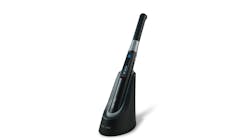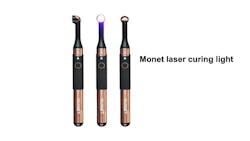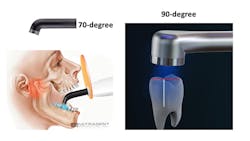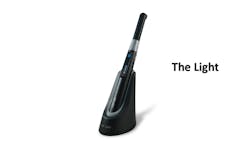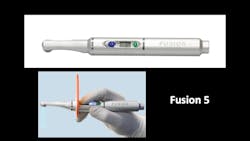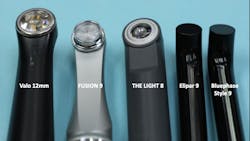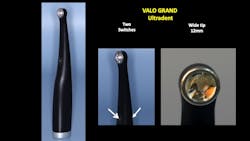What’s wrong with resin curing lights?
Q: I see numerous curing lights on the market that are significantly different from the older LED lights I have been using. I haven’t seen a lack of resin cure with my lights, but they require more time to cure than is being advertised for the newer lights. They have a 70-degree angulation on the fiber-optic bundle carrying the light to the resin, and the tips are much smaller in diameter than the newer lights. Are they OK, or should I change to a newer light?
A: The evolution of curing lights initiated in 1969 has been interesting and required years to get to the current generation of lights. In the 1970s, ultraviolet light (Dentsply Nuva Light) was the device used to polymerize dental resins. During the 1980s, blue light was used, followed by quartz-halogen, and later plasma arc light. In the 1990s and still today, most light curing devices in dentistry are LED lights. They cure in the range of 450 nm to 490 nm. Currently, laser light is promising and challenging the market. This concept needs more long-term research, however (figure 1).
If the lights available today are used properly, they cure restorative dental resins adequately. But there are many variables that can make that cure less effective or inadequate.
Read more from Dr. Christensen ...
Occlusion and caries: Ongoing zirconia challenges
Comparing new vs. older concepts
I was pleased to assist Dr. Richard Price of Halifax University in authoring some papers on this subject.1 We categorized many characteristics for dental curing lights, some of which were physical device characteristics that influence desirable use of the light. Additionally, we identified those characteristics that can directly influence the quality of resin restorations or negatively influence patients or dental professionals. I recommend that you analyze your curing lights and compare them with the following characteristics.
Sealed system for easy cleaning and proper infection control: Unfortunately, curing lights are among several routine clinical items that could use better disinfection. Some lights have surface irregularities, visibly open junctures of the light handle, or intricate, irregular on-off switches. These physical characteristics can negatively influence infection control since disinfecting curing lights usually entails only wiping the light handle and light guide with a disinfectant. Some dentists use plastic sheaths, which can reduce this infection control challenge with just a slight reduction in light effectiveness, according to research by the Clinicians Report Foundation.
Right angle of the curing tip: Many curing lights use fiber-optic bundles to transmit the light to the resin that’s being cured. These fibers (silica, plastic, or other) can tolerate a known amount of bending and still transmit light. This method has been effective in transmitting light for dental resin curing, but if a bundle is bent too much by the manufacturer, light can escape through the fiber cladding or develop microcracks.
How does this affect you? Many dental curing lights on the market today have only an approximately 70-degree angulation on the curing tip. If a patient can only open 20–30 mm, it is difficult to impossible to direct the light beam perpendicular to the resin surface in numerous locations in the mouth. Clinicians Report Foundation scientists have shown that if the light beam is directed even a few degrees from perpendicular to the resin surface, the effectiveness of light curing is significantly reduced.
The ideal angulation for a dental light curing tip is about 90 degrees, and some lights now have this characteristic. Such angulation allows proper positioning of the light guide for almost any clinical situation (figure 2).
Rotating light guide: Although some highly effective curing lights do not have a rotating light guide, dentists complain that they often cannot immediately locate the power switch during the haste of performing a clinical procedure. The challenge of transmitting light through a rotating tip with the potential loss of effectiveness has discouraged some companies from having a rotating light guide. However, finding the activation switch is significantly easier when the operator’s finger can remain on the light switch and the light guide turned to aim properly at the resin being cured (figure 3).
Easily located and activated switch with time settings: Some lights have switches that are confusing, especially to a new or inexperienced user. Simple switches are highly desirable. In my opinion, an on-off switch with an available setting of whatever curing time (in seconds) the operator desires is adequate. Complex switches are not as easily used, especially by infrequent users (figure 4).
Light guide made with material that doesn’t combine with the resin being cured: The light guides on some curing lights collect resin material on them that chemically adheres to the light guide (figure 5). This problem reduces the effectiveness of the light energy and can cause inadequate resin polymerization. If you have such lights, observation of the curing light tip and frequent cleaning is advised. The attached debris can be carefully removed and the tip polished, but it is an inconvenience.
Shield on the curing light: The so-called blue-light hazard is well known, but some dentists don’t take it seriously. I suggest that you go on the internet, put the phrase “blue-light hazard” into Google Scholar or PubMed, and read a few of the papers. You will realize the potential seriousness of this problem for dental professionals.
As dentists, we expose ourselves to potential retinal damage every clinical day when we cure resin. Some curing lights have an orange shield attached to them (figure 4). However, I ask attendees in the courses I teach: How many dentists use light shields? Most don’t. Some use a handheld shield to reduce the challenge. Others aim the curing light at the proper distance from the resin and at the right angulation, stabilizing the position of the curing light with their fingers, and then turn their head completely away from the light or close their eyes while curing.
This procedure seems to be the most common avoidance method. It’s difficult to change human behavior, but I’d advise everyone to learn more about the blue-light hazard, educate your staff about the dangers of it, and incorporate preventive methods into your practice to reduce or eliminate the problem.
Broad-spectrum wavelength with wide-diameter light guide: Most of the newer lights have broad-spectrum wavelength, but some don’t. Valo from Ultradent has been a leader in promoting these features (figure 6). Clinicians Report (CR) Foundation is currently studying the newest version of the Valo light, Valo X. CR has evaluated numerous low-cost lights and found some of them to be inadequate in this regard. If you are using an older-model light, a current inexpensive light, or any light you want to test, investigate the light’s wavelength and follow these simple steps:
- Review your current curing technique: resin used most, color used most, curing time usually used.
- Make a cylindrical sample of the resin about 10 mm high and at least 3 mm in diameter.
- Place the light-guide tip as close as possible to the top of the vertically standing sample.
- Cure the resin using your normal curing time.
- From the bottom of the cylinder, scrape away the resin until it is too hard to remove any more, using significant scraping force with a lab knife.
- You will probably have cured about 2–3 mm of the 10 mm sample. Although this is a very simple test, you now have a reasonable idea of how deeply your light is curing. You may also be surprised to see that the curing depth advertised by some companies is incorrect.
Conclusion
Curing resin restorative materials can easily be done incorrectly. The curing lights available today are the best dentistry has ever had, but some of them have characteristics that reduce their effectiveness. Compare your curing lights with the characteristics discussed here to see if you have optimum light characteristics.
Editor's note: This article appeared in the April 2023 print edition of Dental Economics magazine. Dentists in North America are eligible for a complimentary print subscription. Sign up here.
Reference
1. Price R, Christensen GJ, Braga S. Light-emitting diode polymerization curing lights: attributes and uses. J Cosmet Dent. 2020;36(1).
Author’s note: The following educational materials from Practical Clinical Courses offer further resources on this topic.
One-hour videos:
- Making Foolproof Class II Composites (Item #V3501)
- Mastering Frequent Esthetic Challenges with Resin (Item #V3582)
Two-day hands-on courses in Utah:
- Restorative / Esthetic / Preventive Dentistry with Dr. Gordon Christensen
- Simplifying Complex Treatment with Dr. Gordon Christensen
For more information, visit pccdental.com or contact Practical Clinical Courses at (800) 223-6569.
About the Author

Gordon J. Christensen, DDS, PhD, MSD
Gordon J. Christensen, DDS, PhD, MSD, is founder and CEO of Practical Clinical Courses and cofounder of Clinicians Report. His wife, Rella Christensen, PhD, is the cofounder. PCC is an international dental continuing education organization founded in 1981. Dr. Christensen is a practicing prosthodontist in Provo, Utah.
